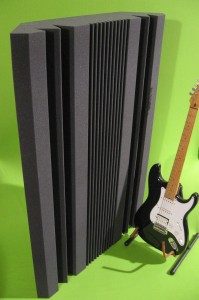Unfortunately there is no standard for measuring corner bass traps, unlike flat wall mounted acoustic panels, which we have assessed at the RMIT acoustic laboratory in Melbourne. So the most practical way of determining bass trap performance is by in-situ testing and measuring reverberation times at various frequencies. A bass trap can be tested as a flat panel in a reverberation chamber down to 100hz, the limitation of accurate measurement. A flat section of 180mm thick 32 Kgm/3 acoustic foam (thickness of BT120/80) absorbs at around 90% at 100 Hz. So at least we know we are off to a good start with the design of a trap, with guaranteed absorption at 100Hz.
When placed across a corner, with a large airgap behind, efficiency is greatly increased. Also, the width of the panel across the corner will increase the efficiency of the panel (the BT120/80 bass trap is 800mm wide) So what we need to assess with in-situ testing is how far below 100hz the bass trap continues to absorb.
For example an empty room, say 5 x 4 metres, will measure a reverberation time of around 1500 – 2000ms at the 64 Hz band.
The placement of 8 BT120/80 (2 in each corner) will reduce the reverberation time to around 500 – 700ms at the 64Hz band, which is significant in terms of improved low frequency definition. It is also useful looking at the effect bass trap installation has on the frequency response of a room, in particular looking at peaks and nulls due to room modes.
There are many variables which effect the performance of bass traps, and whether they achieve the desired result, such as the size and dimensions of the room, the seating position, construction materials, audio system configuration, floor coverings, and adjoining spaces, just to name a few.

